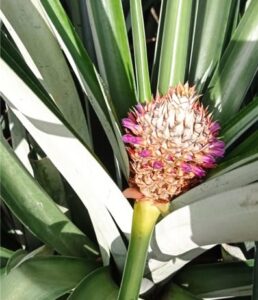Pineapples Plant Information and Environmental Requirements

This post is also available in:
This post is also available in:
![]() Español (Spanish)
Español (Spanish) ![]() Français (French)
Français (French) ![]() Deutsch (German)
Deutsch (German) ![]() हिन्दी (Hindi)
हिन्दी (Hindi) ![]() العربية (Arabic)
العربية (Arabic) ![]() Türkçe (Turkish)
Türkçe (Turkish) ![]() 简体中文 (Chinese (Simplified))
简体中文 (Chinese (Simplified)) ![]() Português (Portuguese (Brazil))
Português (Portuguese (Brazil))

Pineapples Plant Information – Morphology
The pineapple plant is a perennial plant and is the leading edible member of the Bromeliaceae family [1]. The plant’s principal morphological structures include the stem, leaves, peduncle, crown, shoots, and adventitious roots. The plant has an apical meristem that gives rise to the peduncle and inflorescence [2]. Under ideal circumstances, the root system is largely adventitious, as is characteristic of monocots, and may extend up to 1-2 m (3.3-6.5 ft) laterally and 0.85 m (2.8 m) in depth. Root development begins shortly after planting and continues until blooming. Depending on temperature and soil moisture, root development slows but continues throughout the winter. Pineapples have hermaphrodite flowers that have both male and female reproductive organs. The flower petals are tongue-shaped and range in color from white at the base to violet-blue at the tip. Each blossom is enclosed by a thick brace coated with trichomes and has a pointed tip. The sepals are triangular and similar in color and texture to the bracts. The flowers are put in a tight, compact arrangement.
Environmental Requirements of Pineapples
Pineapples grow best in warm, humid weather, so most pineapple farms are between 30°N and 33°58S latitudes. It grows well in places that get between 760 and 1,000 mm of rain well distributed throughout the year. The best area for pineapple growth is in tropical and subtropical areas, up to 1000 meters (328 ft) above sea level, as long as the area doesn’t get frost. At altitudes above that, pineapples grow smaller with more acidic fruits and a less colorful and flavorful pulp. The following needs to be well understood by farmers [3].
- Areas with less than 500-600 mm yearly precipitation need to be irrigated. Areas with more than 3 months of less than 15 mm per month, 4 months of less than 25 mm per month, or 5 months of 40 mm per month are not suitable for pineapple cultivation without irrigation.
- Heavy soils and yearly precipitation above 3,000 mm make harvesting difficult.
The best temperature for growth is between 20 and 30 °C (68 and 86 °F). It is essential that the night temperature is at least 4 oC (around 9 oF) lower than the day temperature. Fruit development slows down between 10 and 16 °C (50 and 61 °F). Pineapple plants can survive in temperatures below freezing for a short time. On the other hand, temperatures over 30 °C (86 °F) can be dangerous because breathing, metabolism, and food absorption all speed up. Furthermore, the fruit gets sunburned when it is out in the sun and the temperature is over 35 °C (95 oF). In fact, when it reaches the fruiting stage, good fruit quality is achieved if there are conditions of cool nights, sunny days, and daytime temperatures between 21 and 29.5 °C (70-85 °F).
Sunlight is another crucial factor for the growth of pineapples, as it allows the plant to have sufficient photosynthesis, increasing the total sugar level in the fruits. On the other hand, fruits contain less total sugar if there is less sunshine. However, excess sunlight and elevated temperatures can cause sunburn and if nothing is done to reduce the stress these conditions cause to the plants, they can lead to a 40% yiled loss. Because of this, areas that get a lot of sunlight should have some shade (e.g., from other trees).
Soil Requirements of Pineapples
The best soils for growing pineapples are sandy loams, clay loams, and loams with good drainage and without heavy clay or rocks in the upper 1 meter of the surface [4]. The pH of the soil should be between 4.5 and 5.6 for pineapples to thrive. On the contrary, the plants do poorly in soils with a pH of more than 7.0. Slopes of 2–6% are ideal for pineapple cultivation when the soil is at least 45–60 cm (18-24 inches) deep. Below this range, adequate drainage may be challenging to achieve. Pineapple growing requires acidic soil rich in organic matter and potassium. Fruit grown on light soil tastes and looks much better. The plant is very susceptible to moist-saturated soils.
References
- Morton, J. F. (1987). Pineapple, Ananas comosus. http://www.hort.purdue.edu/newcrop/morton/pineapple.html1
- Hossain, M.F. (2016). World pineapple production: An overview.DOI: http://dx.doi.org.lp.hscl.ufl.edu/10.18697/ajfand.76.15620
- Neild, R.E. & Boshell, F. (1976). An agroclimatic procedure and survey of the pineapple production potential of Colombia, Pages 81-92. https://doi.org/10.1016/0002-1571(76)90024-8.
- University of Florida extension. (2021). Pineapple. https://gardeningsolutions.ifas.ufl.edu/plants/edibles/fruits/pineapples.html
Pineapple History, Uses and Nutritional Value
Pineapples Plant Information and Environmental Requirements
Soil Requirements and Land Preparation for Pineapple
Planting of Pineapple – Pineapple Plant Density
Pineapple Water Needs and Irrigation Systems
Pineapple Fertilization Requirements








































































